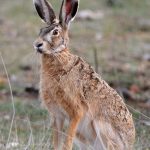 Although they both have long ears and are prepared for the table in a similar manner, hares and rabbits are not considered by zoologists to be the same animal: hares are larger, for example, and do not live in burrows. Nonetheless, their overall resemblance has long caused people to confuse them, resulting in frequent misapplication of their names. The Belgian hare, for example, is actually a rabbit, while the American jackrabbit is actually a hare. The hare acquired its name from a Germanic word pronounced something like khason, a word that may have originally meant grey: the word khason seems, for instance, to have been the source of the Old English hasu, meaning grey, and of the Modern English hoary, meaning grey with age. If grey was indeed the original meaning of khason, then the word was bestowed upon the long-eared animal because of its grey fur, just as the bear acquired its name from an Indo-European word that meant brown. Whatever its original meaning, once the word khason became the Germanic name of the animal, it evolved into the Old English hara, respelt as hare in the twelfth century. Likewise, in German, khason evolved into hase, as in hasenpfeffer, a dish of peppered hare. In the sixteenth century, the word hare also became established in many expressions and compounds. Harelip, for example, came to denote a medical condition in which a person’s upper lip is cleft like that of a hare, while to kiss the hare’s foot came to mean to be late for dinner, the idea being that the latecomer must dine on the only part of the roast hare that remains—its feet.
Although they both have long ears and are prepared for the table in a similar manner, hares and rabbits are not considered by zoologists to be the same animal: hares are larger, for example, and do not live in burrows. Nonetheless, their overall resemblance has long caused people to confuse them, resulting in frequent misapplication of their names. The Belgian hare, for example, is actually a rabbit, while the American jackrabbit is actually a hare. The hare acquired its name from a Germanic word pronounced something like khason, a word that may have originally meant grey: the word khason seems, for instance, to have been the source of the Old English hasu, meaning grey, and of the Modern English hoary, meaning grey with age. If grey was indeed the original meaning of khason, then the word was bestowed upon the long-eared animal because of its grey fur, just as the bear acquired its name from an Indo-European word that meant brown. Whatever its original meaning, once the word khason became the Germanic name of the animal, it evolved into the Old English hara, respelt as hare in the twelfth century. Likewise, in German, khason evolved into hase, as in hasenpfeffer, a dish of peppered hare. In the sixteenth century, the word hare also became established in many expressions and compounds. Harelip, for example, came to denote a medical condition in which a person’s upper lip is cleft like that of a hare, while to kiss the hare’s foot came to mean to be late for dinner, the idea being that the latecomer must dine on the only part of the roast hare that remains—its feet.
A hare is a wild animal that resembles a rabbit but is larger and has darker flesh with a richer flavor. Although it is plentiful in many parts of the United States, it has never been as popular there as it has been in Britain and Europe.
